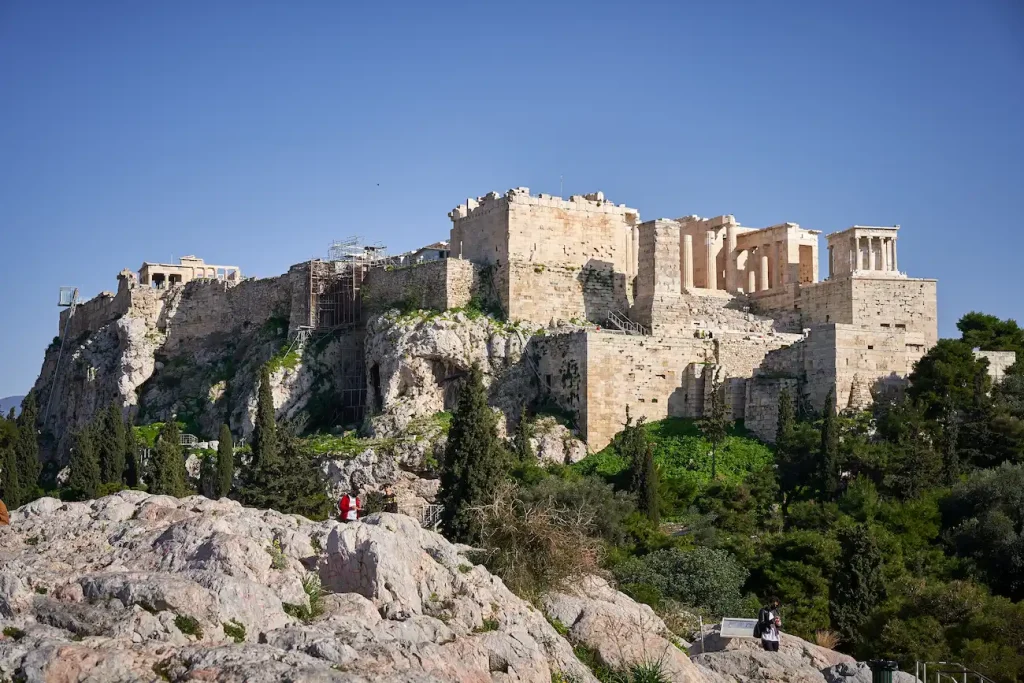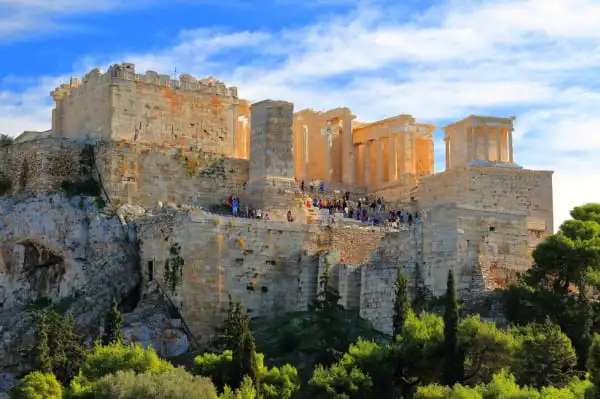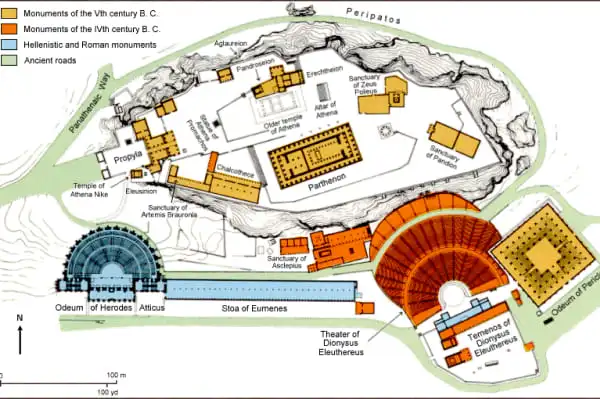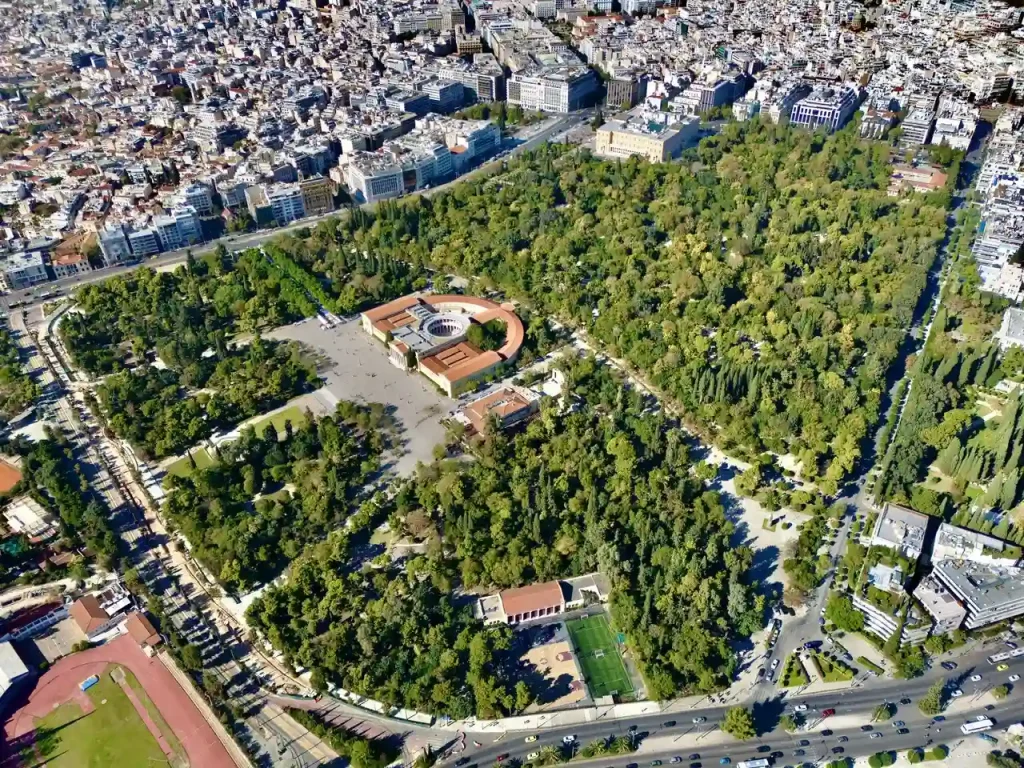Walking and climbing up to the Acropolis
We offer you a practical guide on how to climb the Acropolis and walk around it.
Walking around the Acropolis isn’t just about showing up and wandering around. The moment you start that climb, you’re dealing with ancient marble that’s been polished smooth by millions of footsteps, and trust me, it’s more treacherous than it looks. But with the right preparation, this becomes less about survival mode and more about actually enjoying one of humanity’s greatest architectural achievements.
How long does it take to walk around the Acropolis?
The truth is that there’s no single answer here. The duration of your visit depends entirely on the type of experience you are looking for:
- A quick visit (1-1.5 hours): You’re on a tight schedule, maybe squeezing this in between other Athens sites. This timeframe gets you to the main attractions, the Parthenon and the Erechtheion, with a quick pass through the Propylaea gateway. You’ll catch those stunning panoramic views of Athens, snap some photos, and move on. It’s the highlight reel version, perfect when you’re pressed for time but still want to say you’ve been there.
- More standard visit (2-3 hours): This is what most people end up doing, and honestly, it’s the sweet spot. You get enough time to explore the summit monuments without rushing, plus you can venture down to the South Slope to see the Theatre of Dionysus and the Odeon of Herodes Atticus. Most guided tours operate in this window because it balances thoroughness with stamina. You’ll have time to pause, absorb the history, and not feel like you’re racing against the clock (which is appreciated considering the historical richness of the place.).
- A complete walk through the history of the Acropolis (4+ hours): Reserved for history buffs and photography enthusiasts who want every angle, every detail. This extended visit includes a thorough walk around the perimeter, time to study the smaller monuments, and a visit to the Acropolis Museum. The museum alone needs 1.5 to 2 hours, and it’s where you’ll find the original sculptures and friezes that once adorned these temples. Without seeing the museum, you’re only getting half the story.
But here’s what the guidebooks won’t always emphasize: these times assume moderate crowds and bearable weather. During peak hours (10:00 AM to 2:00 PM), you can add an hour just waiting in queues and navigating through bottlenecks. In temperatures exceeding 30°C, your pace naturally slows as you seek whatever shade exists (spoiler: there isn’t much). The heat reflecting off that white marble creates what visitors accurately describe as “oven-like conditions.”

Is there an elevator?
Yes, but it’s not for general use. The elevator is a crucial accessibility feature, and its use is strictly regulated. It’s intended for:
- Wheelchair users and individuals with significant mobility impairments.
- Visitors with temporary but severe limitations (e.g., using crutches).
- A single parent or guardian with two or more infants.
Look, here’s the critical part: if your disability isn’t immediately visible, you must bring official documentation, like a doctor’s certificate or a government-issued disability ID. You should also call the Acropolis administration in advance at +30 210 3214172 or +30 210 9238470 to confirm it’s running, as it can close for maintenance or high winds.

Which entrance should you use?
The Main (West) Entrance on Rovertou Galli is the classic approach. This is where you get that grand, cinematic moment, walking through the monumental Propylaea gateway, the way ancient Athenians did during sacred processions. It’s equipped with all the facilities: main ticket office, restrooms, gift shop, snack vendors, and luggage storage.
The downside? This is where the crowds congregate. Even with pre-booked tickets, you’re looking at 20-30 minute waits during peak season.
On the other hand, South Slope (Southeast) Entrance on Dionysiou Areopagitou street is your strategic alternative. It leads you through the sites on the South Slope first (the Theatre of Dionysus, the Sanctuary of Asclepius, the Odeon of Herodes Atticus) before you climb to the summit. More importantly, it’s significantly less crowded. With pre-booked tickets, you’ll often face minimal to no waiting time.
In this case, the correct strategy would be to enter from the south and exit from the west.
Important tips to keep in mind when walking around the Acropolis
Let’s talk about what actually makes or breaks this experience, starting with what you put on your feet.
- – Footwear is non-negotiable: The ancient marble paths are incredibly slippery, even when dry. Leave the flip-flops and fashion sneakers at the hotel. You need sturdy, closed-toe shoes with excellent grip (think hiking shoes or trail runners). Your ankles will thank you.
- – Conquer the heat and sun: There is virtually no shade up there. The sun reflects off the white marble, creating an oven-like effect. A wide-brimmed hat, high-SPF sunscreen, and sunglasses are your best friends. And that brings us to…
- – Hydration is a safety issue: Carry at least one liter of water per person. While there are water fountains near the entrances, there are none on the summit. Fill your bottle before you start the climb.
- – Time your visit like a pro: The absolute best times to visit are right at 8:00 am opening or in the late afternoon (after 4:00 pm). You’ll avoid the brutal midday heat and the largest tour groups. The light for photography is also magical during these hours.
- – Buy tickets in advance: This is no longer a suggestion, it’s a necessity. You must purchase timed-entry tickets online before you go. Spontaneous visits, especially in peak season, are nearly impossible now.
- – Know what you can’t bring. Large bags, backpacks, wheeled luggage, tripods, and drones are prohibited. Only small day bags or purses are allowed. To protect the monuments, food and any beverage other than water are strictly forbidden. There’s luggage storage at the main entrance if you need it.
- – Restroom facilities are limited. They’re located near the entrances but scarce on the main site itself. Use the facilities before you start your climb, this isn’t just advice, it’s based on reports that the on-site toilets have been under renovation and temporarily closed at times.
- – Don’t skip the Acropolis Museum. It’s where you’ll find the original Parthenon sculptures, metopes, and one of the original Caryatids. Seeing these artifacts provides essential context to the ruins you just walked through. The museum is fully climate-controlled (a blessed relief after the heat of the hill) and requires 1.5 to 2 hours for a proper visit.
Acropolis key information
Taking the metro is a quick and convenient option for getting to the Acropolis in Athens. There are two metro stations that can be used to re…
The Acropolis has played a significant role in Greek history and culture and is widely regarded as one of the most important archaeological…
Find out when is the best time to visit the Acropolis, both to avoid queues and to protect yourself from the heat of Athens….
Explore with us all the places of interest you can visit near the Acropolis and create your best possible trip….
How accessible is a walk around the Acropolis?
This is a mixed bag, but there has been fantastic progress. For visitors with mobility issues, seniors, and wheelchair users, planning is paramount.
For wheelchair users and visitors with mobility impairments, the 2020 installation of a modern slope elevator and accessible pathways represents a genuine breakthrough. The elevator, a joint project between the Greek state and the Onassis Foundation, replaced an older, unreliable construction lift that was frequently broken. This new system can carry up to two wheelchairs with companions (or up to 18 people total, with a load capacity of 1,300 kg), and the ascent to the summit takes just 32 seconds.
The approach to the elevator uses specialized 6-seat vehicles to transport eligible visitors from the street level to the elevator platform, overcoming the initial incline. Once at the top, new paved routes approximately 4 meters wide run along the north and east sides of the Parthenon, allowing wheelchair users to navigate between the major monuments.
It’s estimated that approximately 70% of the site is now reachable via these paved paths. The remaining 30% remains ancient, uneven, and rocky, inherently inaccessible.
For seniors and visitors with limited mobility who don’t use wheelchairs, the reality is more challenging. The climb involves a 15-20 minute ascent on inclined, uneven paths before you even reach the main plateau. The ancient marble is slippery, the heat can be debilitating, and there’s minimal shade for rest breaks. Early morning or late afternoon slots become even more critical, not just for crowds, but to avoid the physical stress of midday heat.
Finally, Acropolis Museum is fully wheelchair accessible and should be considered an essential part of your visit, especially if navigating the outdoor terrain of the hill proves challenging.

Is it worth taking a walking tour or a guided tour?
This is one of the most common dilemmas for visitors. Is it better to have an expert lead the way, or to discover the Acropolis on your own terms? Let’s break down both options so you can decide what’s best for you.
Think of it this way: anyone can walk up the hill and see the stones. But a great guide doesn’t just show you the ruins, helps you understand the historical context and the true importance of the place.
On the other hand, going solo gives you the ultimate freedom to wander, ponder, and connect with the site in your own personal way…
The Case for a Guided Tour
This is one of the most common dilemmas for visitors. Is it better to have an expert lead the way, or to discover the Acropolis on your own terms? Let’s break down both options so you can decide what’s best for you.
Think of it this way: anyone can walk up the hill and see the stones. But a great guide doesn’t just show you the ruins, helps you understand the historical context and the true importance of the place.
On the other hand, going solo gives you the ultimate freedom to wander, ponder, and connect with the site in your own personal way…
If you’re a first-time visitor or a history enthusiast, a guide can be a game-changer.
First of all, without context, it’s easy to just see “old buildings.” A knowledgeable guide explains why the Parthenon is a revolutionary piece of architecture, what the Erechtheion was actually used for, and the dramas of the gods and goddesses worshipped here. They turn facts into a compelling narrative.
In addition, you skip the stress, because a guide handles the logistics. They know the best routes, have your entry sorted, and navigate the crowds efficiently. This “hassle-free” aspect lets you completely focus on the experience instead of worrying about where to go next. Many tours provide headsets, so you can always hear the commentary even in a crowded spot.
The Case for Going Solo
If you cherish independence or are traveling on a tight budget, exploring on your own is a fantastic and rewarding option.
Feel like spending an hour sketching the Parthenon? Want to sit and just soak in the view for twenty minutes? You can. This is especially valuable for photographers, families with young children, or anyone who needs to take frequent breaks.
Obviously, you save money. This is the most significant financial advantage. The cost of a standard entry ticket is far less than a guided tour. By using free or low-cost resources, you can have a deeply informative experience without the premium price tag.
But you’re not truly alone. The free Rick Steves Audio Europe tour is a legendary resource among travelers. It’s engaging, easy to follow, and gives you a solid narrative structure for your visit.
What's the Verdict?
Your choice ultimately depends on what you value most.
If your time is limited, you’re a first-timer who wants to “see it all” efficiently, you detest logistical planning, or you’re a history buff craving deep, expert context.
If you are on a tight budget, you highly value autonomy and moving at your own rhythm, or you’re happy to do a little pre-trip research and leverage a powerful audio guide.




